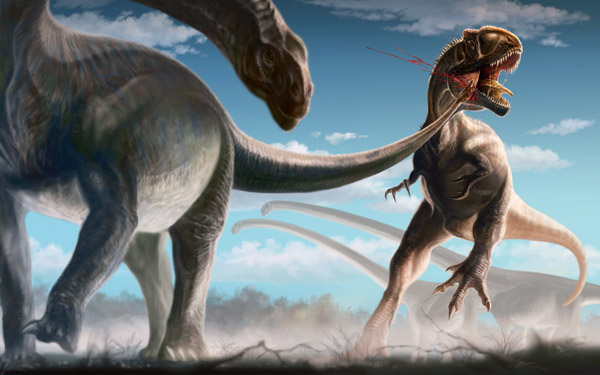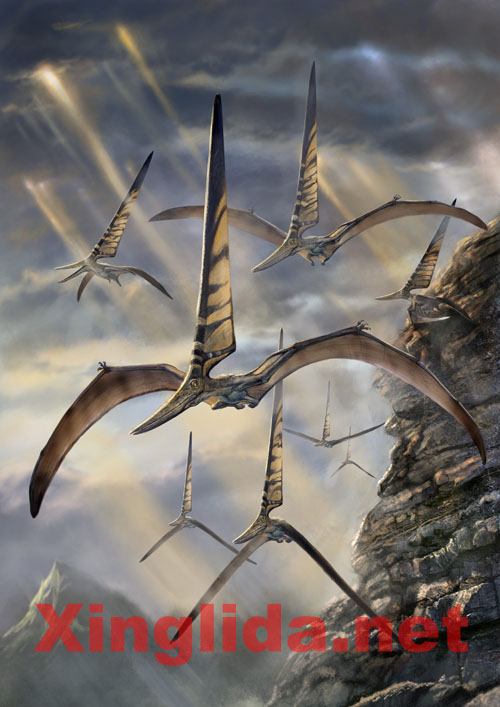|
 New
Papers New
Papers
Structure, Orientation and Finite Element Analysis of the Tail
Club of Mamenchisaurus hochuanensis
Xing, Li-da1)*, Ye, Yong2), Shu, Chun-kang2), Peng, Guang-zhao2), & You,
Hai-lu1)
1, Institute of Geology, Chinese Academy of Geological Sciences, Beijing,
100037, P. R. China
2, Zigong Dinosaur Museum, Zigong, 643013, P. R. China
Abstract: The structure and orientation of the posterior extremity of the
caudal vertebrae (tail club) of Mamenchisaurus hochuanensis has been
studied by Ye et al. 2001 and Ouyang and Ye 2002. This research describes the
structure of the tail club of M. hochuanensis ZDM0126 in detail,
analysis its function using Finite Element Analysis. The result supports the
conclusion that the cranial end of the tail club is fixed, connected with the
sequence of the caudal vertebrae, the caudal end is free and is the terminal of
the caudal vertebrae. The estimate herein is different from the traditional
viewpoint towards the tail club orientation of M. hochuanensis. Further
it is determined that the tail club is more efficient in swinging from left to
right than up and down; the best region for the tail club to impact is the
region of C2 spine. The maximum load for impact is 450N. Based on the
articulation form of the tail club and the feature of enlarged neural foreman,
this paper confirms that the tail club of ZDM0126 has limitations as a defense
weapon, and is more possibly a sensory organ to improve the nerve conduction
velocity to enhance the capacity for sensory perception of the surroundings.
Key words: Mamenchisaurus, Tail Club, Finite Element Analysis, Shangshaximiao Formation, Upper Jurassic
Download
PDF
 |
|
Mamenchisaurus hochuanensis
VS. Yangchuanosaurus (By Zhang zhognda) |
++++++++++++++++++++++++++++++++++++++++++++++++++++++++++++++++++++++++++++++++++++++++++++
Aerodynamic Characteristics of the Crest with Membrane
Attachment on Cretaceous Pterodactyloid Nyctosaurus
XING Lida1*,
WU Jianghao2*, LU
Yi2, LÜ Junchang1
and JI Qiang1
1 Institute of Geology, Chinese Academy of Geological Sciences, Beijing 100037
2 School of Transportation Science and Engineering, Beijing University of
Aeronautics and Astronautics, Beijing 100083
Abstract: The Nyctosaurus specimen KJ1 is reconstructed under the
hypothesis that there is a membrane attached to the crest, the so-called
headsail crest. The aerodynamic forces and moments acting on headsail crest are
then analyzed. It is shown that KJ1 might adjust the angle of the headsail crest
relative to the air current as one way to generate thrust (one of the
aerodynamic forces, used to overcome body drag in forward flight) and that the
magnitude of the thrust and moment could vary with the gesture angle and the
relative location between the aerodynamic center of headsail crest and body’s
center of gravity. Three scenarios are tested for comparison to each other: the
crest with membrane attachment, the crest without membrane attachment and the
absence of cranial crest. It is shown that the aerodynamic characteristics
(increasing, maintaining and decreasing thrusts and moments) would almost
disappeared in flight for the crest without membrane attachment and none
existent without the cranial crest. It is suggested from aerodynamics evidence
alone that Nyctosaurus specimen KJ1 had membrane attached to the crest
and used this reconstructed form for auxiliary flight control.
Key words: aerodynamic forces and moments, flight dynamics,
Nyctosaurus, headsail crest
More Images
Download PDF 5.57M

Nyctosaurus KJ (illustration by Chuang Zhao and Lida Xing)
|
|


